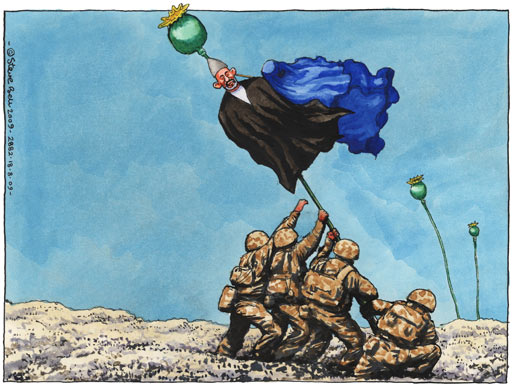
Karzai CIA poppies slush funds
Osama has (not) left the building
By Pepe Escobar
For the dubious privilege of financing the 16-agency, alphabet soup, United States intelligence establishment not to find Osama bin Laden and al-Qaeda's number two Ayman al-Zawahiri, US taxpayers have been plundered to the staggering tune of US$500 billion - and counting. Still, the obvious questions resonate from Seattle to Selma and from Sweden to Swaziland. Where's Osama? Where's al-Zawahiri? Where's escaped-on-the-back-of-a-motorcycle Taliban supremo Mullah Omar?
For starters, why don't US intelligence agencies ask the French Foreign Ministry? They swear on their Dior ties Osama is indeed alive - and it is his jihadi master's voice showcased in an audiotape broadcast by al-Jazeera this past Wednesday. In the tape, Osama in so many words warns France that the Eiffel Tower may experience a different kind of wobble one of these days (it has been evacuated twice lately).
Osama - or the ghost passing for Osama - said: "If you want to tyrannize and think that it is your right to ban the free women from wearing the burqa, isn't it our right to expel your occupying forces, your men from our lands by striking them by the neck?" A jittery Paris has taken the analogy extremely seriously.

A room with a view
So now that it's established that Osama seems to be alive and well, having made a successful transition from TDK cassettes to MP3 (unless very circumspect French diplomats are lying; and unless we suppress roars of laughter at the assertion by row after row of US "intelligence analysts" that fake Osama tapes have never been broadcast), comes the question of his humble abode.
So why not turn to the formidable North Atlantic Treaty Organization (NATO) and its arrays of the most sophisticated military hardware in the world - after all they are spectacularly losing a war in Afghanistan itself as we speak? (The legendary Mikhail Gorbachev - who knows a thing or two about losing a war in the Hindu Kush - has just made it plain and simple: "Victory is impossible in Afghanistan. Obama is right to pull the troops out. No matter how difficult it will be.")
Anyway, NATO officials recently leaked to global corporate media that Osama is hiding "somewhere in northeastern Pakistan". Oh really? Would that be Miram Shah, across from Paktika? Would that be Parachinar, across from Nangarhar (where Osama and al-Zawahiri escaped to from Tora Bora in December 2001)? Would that be Chitral, across from Kunar? Would that be on the Karakoram Highway near the Chinese border?
Radio silence. The NATO boys simply don't know - as they don't seem to be very familiar with the intricate mountain geography and tribal rivalries south of the Hindu Kush. Seems like the NATO boys are taking a cue from those rows of so-called US "intelligence analysts" swearing over their air-con think-tank offices that Osama still oversees the "strategic direction" of al-Qaeda from a base "somewhere in Pakistan". Pakistan happens to be twice as big as California. Try finding a stray wacko in the Mojave Desert.
NATO boys also swear that Mullah Omar is commuting between Quetta, Balochistan's capital, and Karachi. Well, he could be taking a night desert bus or a donkey caravan - and still he can't be found. Has anyone searched the VIP rooms at the Serena Hotel in Quetta, perhaps?
Maybe the Pakistani intelligence apparatus knows something. "Not us!" - screams the Pakistani ambassador to the US, Hussain Haqqani, "The reason why this statement is not made officially and publicly by NATO is because they do not have any basis to make that statement."
Well, then certainly Pakistan's Inter-Services Intelligence knows - or some key operatives inside the ISI. And in this case, the Central Intelligence Agency would know. Ambassador Haqqani: "If anybody thinks that Pakistan has any interest in protecting bin Laden they are smoking something they shouldn't be smoking." Well, apparently no one is smoking Hindu Kush's finest - because Haqqani still swears Washington and NATO have shared "no intelligence" with Pakistan about Osama for a few years now. Would it be because - as in the famous Hollywood dictum - no one knows anything?

The invisible man
In real life, the fact is that a selected few inside the ISI know - as they have followed Osama's every move since the early 1980s in Peshawar. And they are not talking - never will. But for the CIA and the 16-agency alphabet-soup intel community not to know, this speaks volumes about an "intelligence" establishment where 1 million Americans hold top-secret clearances. Those 1 million are absolutely worthless when it comes to gathering on-the-ground intelligence south of the Hindu Kush.
So maybe they should ask the Pakistani Army. General Ashfaq Parvez Kiani - a Pentagon darling - has been to Washington for the third round of what is called a "strategic dialogue" with the Pentagon. It's easy to picture Admiral Mike Mullen, chairman of the Joint Chiefs of Staff, asking Kiani, "If North Waziristan is the epicenter of terrorism, where al-Qaeda is holed up, why don't you go there with all guns blazing and snatch them for us?"
In principle, Kiani will do it - that's what he has promised the Pentagon. But will he? Not really. Kiani will scare away - just for show - the Haqqanis, led by Sirajuddin Haqqani, eldest son of legendary mujahid Jalaluddin Haqqani, while ISI operatives duly tell them to run the other way.
Chapman Base in Khost, Afghanistan, on the other side of North Waziristan, is operated by the CIA. But don't expect Chapman to come out swinging exhibiting "dead or alive" al-Qaeda scalpels. There are indeed some Arab al-Qaeda jihadis sheltered by the Haqqanis - a few dozen at max, but they will have plenty of time to get out of Dodge, thanks again to the services of those ISI agents.
Moreover, Kiani is not suicidal. He knows the Haqqanis and the myriad groups they protect are intimately linked to the Punjabi Taliban. If Kiani launches a major offensive, blowback - in the form of an epidemic of urban suicide bombings rocking Pakistan - is an absolute certainty.

Blowback is on the way anyway - because in this "no one knows anything, and no one's talking" scenario, the only real weapon available for Washington is to drone North Waziristan to death.
Granted, the Barack Obama administration is also desperately trying to find a way out in AfPak. Saudi Arabia is key. Not only Mullah Omar, but also other viscerally anti-occupation Afghan leaders such as Gulbuddin Hekmatyar and Abdul Rasul Sayyaf maintain very close ties with Saudi Arabia. Washington now depends on Saudi Arabia to convince them to sit down and talk.
That's not a given (they all say they're not talking). And even if they did it might - or might not - lead to an endgame (the Pentagon certainly doesn't want one). As for the Pakistani army and intelligence establishment, what they do want is an Afghan satellite government, still part of the "strategic depth" doctrine, and to keep receiving military aid from Washington till perpetuity. Thus playing a double game is key - and that applies most of all to Osama and al-Zawahiri, the golden rationale behind the everlasting "war on terror" - another name for the Pentagon's "long war".

Now you see them - now you don't. So expect a lot of Osama digital audio from now on. He should consider his own podcast on iTunes. There's no real prospect in sight that Osama will honor former US vice president Dick Cheney's correctional facilities anytime soon. He has not left the building, and is now merrily singing Suspicious Minds in a double bill with Elvis.










